A spatiotemporally coordinated cascade of protein kinase C activation controls isoform-selective translocation
- PMID: 16508001
- PMCID: PMC1430303
- DOI: 10.1128/MCB.26.6.2247-2261.2006
A spatiotemporally coordinated cascade of protein kinase C activation controls isoform-selective translocation
Abstract
In pituitary GH3B6 cells, signaling involving the protein kinase C (PKC) multigene family can self-organize into a spatiotemporally coordinated cascade of isoform activation. Indeed, thyrotropin-releasing hormone (TRH) receptor activation sequentially activated green fluorescent protein (GFP)-tagged or endogenous PKCbeta1, PKCalpha, PKCepsilon, and PKCdelta, resulting in their accumulation at the entire plasma membrane (PKCbeta and -delta) or selectively at the cell-cell contacts (PKCalpha and -epsilon). The duration of activation ranged from 20 s for PKCalpha to 20 min for PKCepsilon. PKCalpha and -epsilon selective localization was lost in the presence of Gö6976, suggesting that accumulation at cell-cell contacts is dependent on the activity of a conventional PKC. Constitutively active, dominant-negative PKCs and small interfering RNAs showed that PKCalpha localization is controlled by PKCbeta1 activity and is calcium independent, while PKCepsilon localization is dependent on PKCalpha activity. PKCdelta was independent of the cascade linking PKCbeta1, -alpha, and -epsilon. Furthermore, PKCalpha, but not PKCepsilon, is involved in the TRH-induced beta-catenin relocation at cell-cell contacts, suggesting that PKCepsilon is not the unique functional effector of the cascade. Thus, TRH receptor activation results in PKCbeta1 activation, which in turn initiates a calcium-independent but PKCbeta1 activity-dependent sequential translocation of PKCalpha and -epsilon. These results challenge the current understanding of PKC signaling and raise the question of a functional dependence between isoforms.
Figures
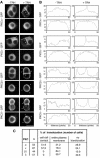
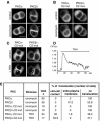
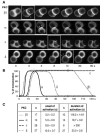
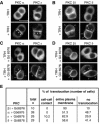
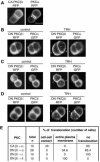



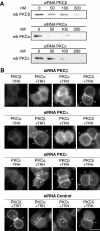


Similar articles
-
Differential role of PKC isoforms in GnRH and phorbol 12-myristate 13-acetate activation of extracellular signal-regulated kinase and Jun N-terminal kinase.Endocrinology. 2010 Oct;151(10):4894-907. doi: 10.1210/en.2010-0114. Epub 2010 Sep 1. Endocrinology. 2010. PMID: 20810567
-
Translocation of protein kinase Cepsilon and protein kinase Cdelta to membrane is required for ultraviolet B-induced activation of mitogen-activated protein kinases and apoptosis.J Biol Chem. 1999 May 28;274(22):15389-94. doi: 10.1074/jbc.274.22.15389. J Biol Chem. 1999. PMID: 10336426
-
Role of specific protein kinase C isozymes in mediating epidermal growth factor, thyrotropin-releasing hormone, and phorbol ester regulation of the rat prolactin promoter in GH4/GH4C1 pituitary cells.Mol Endocrinol. 2002 Dec;16(12):2840-52. doi: 10.1210/me.2001-0305. Mol Endocrinol. 2002. PMID: 12456804
-
PKC and the control of localized signal dynamics.Nat Rev Mol Cell Biol. 2010 Feb;11(2):103-12. doi: 10.1038/nrm2847. Nat Rev Mol Cell Biol. 2010. PMID: 20094051 Review.
-
The Role of Protein Kinase C During the Differentiation of Stem and Precursor Cells into Tissue Cells.Biomedicines. 2024 Nov 29;12(12):2735. doi: 10.3390/biomedicines12122735. Biomedicines. 2024. PMID: 39767642 Free PMC article. Review.
Cited by
-
BAFF controls B cell metabolic fitness through a PKC beta- and Akt-dependent mechanism.J Exp Med. 2006 Oct 30;203(11):2551-62. doi: 10.1084/jem.20060990. Epub 2006 Oct 23. J Exp Med. 2006. PMID: 17060474 Free PMC article.
-
Paclitaxel inhibits the activity and membrane localization of PKCα and PKCβI/II to elicit a decrease in stimulated calcitonin gene-related peptide release from cultured sensory neurons.Mol Cell Neurosci. 2017 Jul;82:105-117. doi: 10.1016/j.mcn.2017.04.001. Epub 2017 Apr 9. Mol Cell Neurosci. 2017. PMID: 28404507 Free PMC article.
-
The stability of Fbw7α in M-phase requires its phosphorylation by PKC.PLoS One. 2017 Aug 29;12(8):e0183500. doi: 10.1371/journal.pone.0183500. eCollection 2017. PLoS One. 2017. PMID: 28850619 Free PMC article.
-
Activated Protein Kinase C (PKC) Is Persistently Trafficked with Epidermal Growth Factor (EGF) Receptor.Biomolecules. 2020 Sep 7;10(9):1288. doi: 10.3390/biom10091288. Biomolecules. 2020. PMID: 32906765 Free PMC article.
-
Thyrotropin-releasing hormone (TRH) in the cerebellum.Cerebellum. 2008;7(1):84-95. doi: 10.1007/s12311-008-0033-0. Cerebellum. 2008. PMID: 18418668 Review.
References
-
- Ahn, S., S. K. Shenoy, H. Wei, and R. J. Lefkowitz. 2004. Differential kinetic and spatial patterns of beta-arrestin and G protein-mediated ERK activation by the angiotensin II receptor. J. Biol. Chem. 279:35518-35525. - PubMed
-
- Alvaro, V., L. Levy, C. Dubray, A. Roche, F. Peillon, B. Querat, and D. Joubert. 1993. Invasive human pituitary tumors express a point-mutated alpha-protein kinase-C. J. Clin. Endocrinol. Metab. 77:1125-1129. - PubMed
-
- Babwah, A. V., L. B. Dale, and S. S. Ferguson. 2003. Protein kinase C isoform-specific differences in the spatial-temporal regulation and decoding of metabotropic glutamate receptor 1a-stimulated second messenger responses. J. Biol. Chem. 278:5419-5426. - PubMed
-
- Braun, D. C., Y. Cao, S. Wang, S. H. Garfield, G. M. Hur, and P. M. Blumberg. 2005. Role of phorbol ester localization in determining protein kinase C or RasGRP3 translocation: real-time analysis using fluorescent ligands and proteins. Mol. Cancer Ther. 4:141-150. - PubMed
Publication types
MeSH terms
Substances
LinkOut - more resources
Full Text Sources
